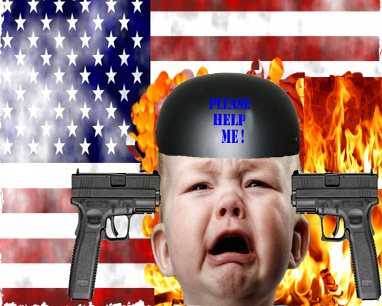With the escalation of American violence, it is easy to blame the vast availability of guns as the only culprit. But is it enough to control the access to guns? Not likely. Clearly the availability of chemicals and technology for explosive devices, in addition to the myriad of other ways to create destruction and harm are here to stay. Building fences and sequestering cultures are not the answer as well. Although gun availability is undoubtedly a major contributing factor, sadly these issues are becoming increasingly reduced to empty, emotional rhetoric and rallying cries for politicians. Given the history of these issues, and particularly gun control in America, it is unlikely they will be settled anytime soon. Truly, it makes far more sense to move past these polarizing issues and instead focus our discussion on an actual solution that can unite all of us - one that both sides of the aisle can agree upon.
Guns, weapons, explosives, and other forms of destruction are merely symptoms of a more primary and central culprit that is at the heart of violence in America - our most primitive instinct. For the purposes of this discussion, I will refer to this as the survival instinct. Our survival instinct evolved for the purpose of keeping us out of danger, such as running from a charging lion or an incoming spear. Yet the very instinct that has allowed us to survive as a species through the millenniums, is the very gut response that is literally putting us in harm's way. It is now fomenting what it was meant to avert. As civilization has advanced, humans have become increasingly less controlled by their most primitive instincts. Unfortunately, it appears that our progression as a species is stalling and regretfully, reverting to ancient times when our instincts were at the helm.
If we are truly interested in reversing America's tide of self-destruction, then it is imperative to directly address the ever sensitive, hair trigger survival instinct. At the pulse of the precarious survival instinct is our growing inability to manage discomfort. Essentially, we are becoming insidiously less and less hardy in the face of stress, pressure, competition, disappointments, frustrations, and uncertainty. As our level of poorly managed discomfort elevates within us, the greater probability of the survival instinct will be triggered.
Discomfort is like an internal pressure cooker, where it starts out simmering, but left unattended can quickly reach a boiling point. The earliest stages of mismanaged discomfort are first noticeable as symptoms: poor sleep, rumination, compulsions, impatience, withdrawal, irritability, poor performance and decision making under pressure, stomach and head/back pain, and other forms of physical illness. In later stages, rising levels of unabated discomfort begins to materialize in the form of addictions, intolerance, self-righteousness, rage, hostility, and antisocial behavior.
Once discomfort has reached a boiling point, it develops a strong foothold, feeds on itself, becomes a ticking time bomb, looks for an escape hatch, and can explode at the slightest provocation. Intervening at such a late stage, as we are learning, does little to change the future. It's like putting out a forest fire, which as we are learning, can set the stage for potentially bigger fires in the future. As long as the forest remains dry and flammable, putting out a forest fire does little to alter the remaining landscape, leaving it vulnerable to the slightest spark.
Can we really afford to continually be in the precarious position of continually waiting for each new spark and explosion? Certainly, this strategy does not appear to be working. The problem is fixable.
The bottom line is that we need to train our children, adolescents, and young adults to be much hardier in the face of discomfort. Regrettably, they are not receiving training in this area. Given the greater availability of funding and psychological resources than ever before, you would think that the tide would have favorably shifted. Yet this isn't the case, the situation is deteriorating. Instruction in positive thinking, taking deep breaths, and relaxation training are not enough, nor should school teachers be held responsible or be expected to fix it.
By far the best solution to counter the expanding dominance of our survival instinct is to intervene when discomfort is at its most incipient stages. Our primitive instincts were never designed for the world we currently live in, so it's no surprise that they can lead us to overreact, misrepresent reality, and even lead us to self-destruction. Since discomfort is inevitable, and life is not likely to become less demanding and pressure-packed, we have no alternative but to train ourselves to be tougher in the face of discomfort. I refer to this type conditioning as Discomfort Training, Discomfort Training is a course I offer to UCLA medical students and the UCLA athletic teams to boost their performance in situations where there is pressure, competition, or unsavory conditions.
More about Discomfort Training can be found in an article that was published in the journal of the United States Olympic Committee, Fall 2015, page 25-31. This article can be found here: http://go.teamusa.org/1Rr0Xg2
In subsequent articles, I will more elaborately discuss what can be specifically done to build hardiness, as well as, Discomfort Training, and the management and treatment of an overactive survival instinct.

